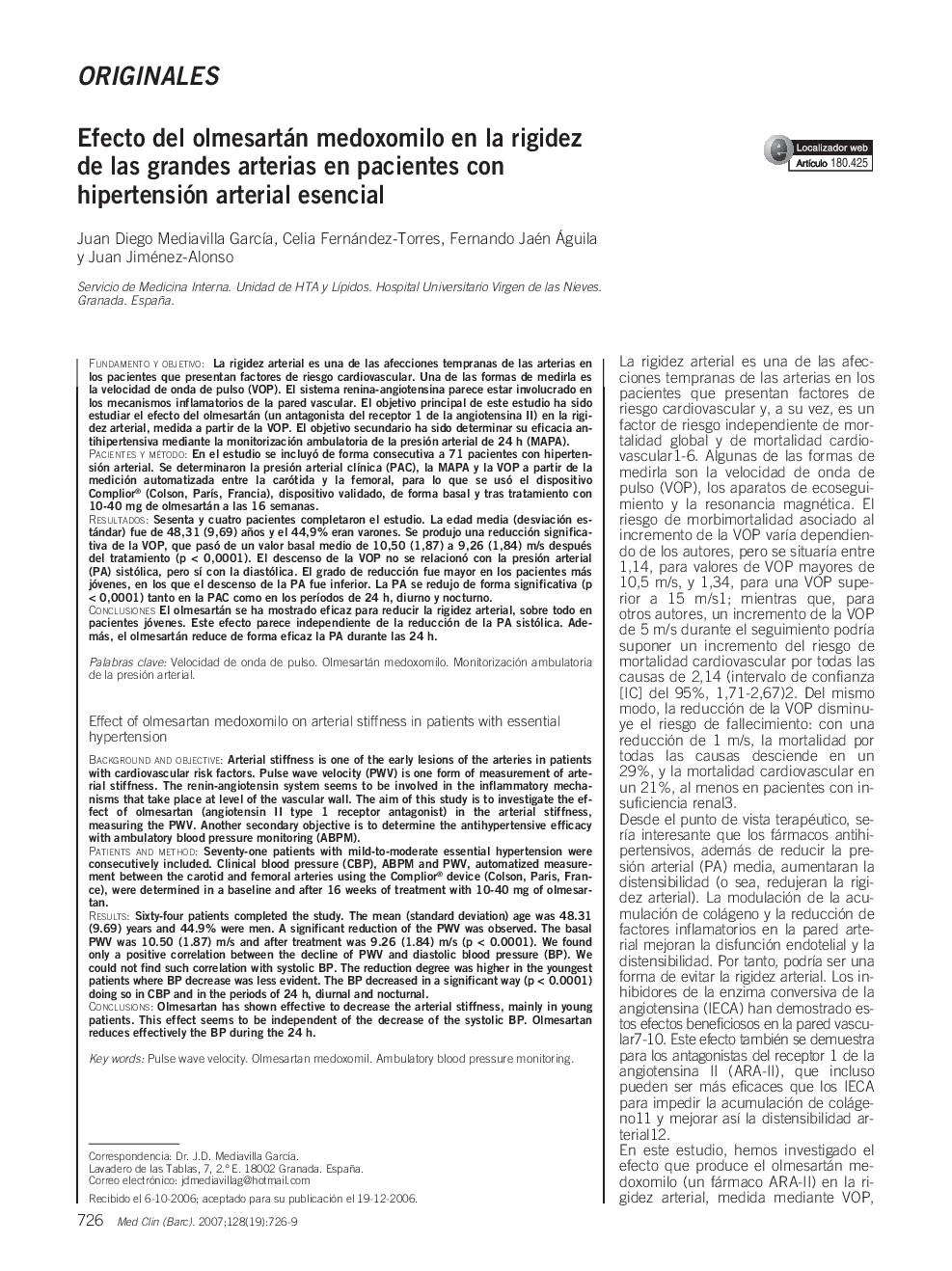| کد مقاله | کد نشریه | سال انتشار | مقاله انگلیسی | نسخه تمام متن |
|---|---|---|---|---|
| 3802704 | 1244824 | 2007 | 4 صفحه PDF | دانلود رایگان |

Fundamento y objetivoLa rigidez arterial es una de las afecciones tempranas de las arterias en los pacientes que presentan factores de riesgo cardiovascular. Una de las formas de medirla es la velocidad de onda de pulso (VOP). El sistema renina-angiotensina parece estar involucrado en los mecanismos inflamatorios de la pared vascular. El objetivo principal de este estudio ha sido estudiar el efecto del olmesartán (un antagonista del receptor 1 de la angiotensina II) en la rigidez arterial, medida a partir de la VOP. El objetivo secundario ha sido determinar su eficacia antihipertensiva mediante la monitorización ambulatoria de la presión arterial de 24 h (MAPA).Pacientes y métodoEn el estudio se incluyó de forma consecutiva a 71 pacientes con hipertensión arterial. Se determinaron la presión arterial clÃnica (PAC), la MAPA y la VOP a partir de la medición automatizada entre la carótida y la femoral, para lo que se usó el dispositivo Complior® (Colson, ParÃs, Francia), dispositivo validado, de forma basal y tras tratamiento con 10-40 mg de olmesartán a las 16 semanas.ResultadosSesenta y cuatro pacientes completaron el estudio. La edad media (desviación estándar) fue de 48,31 (9,69) años y el 44,9% eran varones. Se produjo una reducción significativa de la VOP, que pasó de un valor basal medio de 10,50 (1,87) a 9,26 (1,84) m/s después del tratamiento (p < 0,0001). El descenso de la VOP no se relacionó con la presión arterial (PA) sistólica, pero sà con la diastólica. El grado de reducción fue mayor en los pacientes más jóvenes, en los que el descenso de la PA fue inferior. La PA se redujo de forma significativa (p < 0,0001) tanto en la PAC como en los perÃodos de 24 h, diurno y nocturno.ConclusionesEl olmesartán se ha mostrado eficaz para reducir la rigidez arterial, sobre todo en pacientes jóvenes. Este efecto parece independiente de la reducción de la PA sistólica. Además, el olmesartán reduce de forma eficaz la PA durante las 24 h.
Background and objectiveArterial stiffness is one of the early lesions of the arteries in patients with cardiovascular risk factors. Pulse wave velocity (PWV) is one form of measurement of arterial stiffness. The renin-angiotensin system seems to be involved in the inflammatory mecha-nisms that take place at level of the vascular wall. The aim of this study is to investigate the effect of olmesartan (angiotensin II type 1 receptor antagonist) in the arterial stiffness, measuring the PWV. Another secondary objective is to determine the antihypertensive efficacy with ambulatory blood pressure monitoring (ABPM).Patients and methodSeventy-one patients with mild-to-moderate essential hypertension were consecutively included. Clinical blood pressure (CBP), ABPM and PWV, automatized measurement between the carotid and femoral arteries using the Complior® device (Colson, Paris, France), were determined in a baseline and after 16 weeks of treatment with 10-40 mg of olmesartan.ResultsSixty-four patients completed the study. The mean (standard deviation) age was 48.31 (9.69) years and 44.9% were men. A significant reduction of the PWV was observed. The basal PWV was 10.50 (1.87) m/s and after treatment was 9.26 (1.84) m/s (p < 0.0001). We found only a positive correlation between the decline of PWV and diastolic blood pressure (BP). We could not find such correlation with systolic BP. The reduction degree was higher in the youngest patients where BP decrease was less evident. The BP decreased in a significant way (p < 0.0001) doing so in CBP and in the periods of 24 h, diurnal and nocturnal.ConclusionsOlmesartan has shown effective to decrease the arterial stiffness, mainly in young patients. This effect seems to be independent of the decrease of the systolic BP. Olmesartan reduces effectively the BP during the 24 h.
Journal: Medicina ClÃnica - Volume 128, Issue 19, May 2007, Pages 726-729